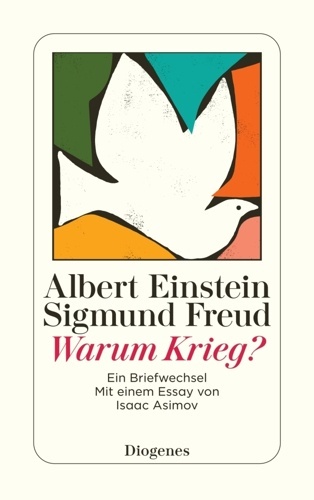Warum Krieg?
Ein Briefwechsel

Einstein, Albert
Freud, Sigmund
Editorial Diogenes
Fecha de edición enero 2008
Idioma alemán
EAN 9783257200287
64 páginas
Libro
encuadernado en tapa blanda
Resumen del libro
Albert Einstein, geboren 1879 in Ulm, stellte die Relativitätstheorie auf, mit der er neue Grundlagen für die moderne Physik schuf. 1921 erhielt er den Nobelpreis für Physik. Als Autor kennt man ihn vor allem durch seine Briefe: berühmt sein Schreiben an Präsident Roosevelt, in dem er - überzeugter Pazifist - sich aus Furcht vor einer deutschen Aggression für die Entwicklung der Atombombe aussprach. Seine Laufbahn als Professor führte ihn über Zürich, Prag und Berlin nach Princeton, wo er 1955 starb.
Autorenportrait
--------------------------------------------------------------------------------
Sigmund Freud wurde 1856 in Freiberg (Mähren) geboren. Nach dem Studium der Medizin wandte er sich während eines Studienaufenthalts in Paris, unter dem Einfluss J.-M. Charcots, der Psychopathologie zu. Anschlie end beschäftigte er sich in der Privatpraxis mit Hysterie und anderen Neurosenformen. Er begründete die Psychoanalyse und entwickelte sie fort als eigene Behandlungs- und Forschungsmethode sowie als allgemeine, auch die Phänomene des normalen Seelenlebens umfassende Psychologie. 1938 emigrierte Freud nach London, wo er 1939 starb.
Biografía del autor
Albert Einstein was born at Ulm, in Württemberg, Germany, on March 14, 1879. Six weeks later the family moved to Munich, where he later on began his schooling at the Luitpold Gymnasium. Later, they moved to Italy and Albert continued his education at Aarau, Switzerland and in 1896 he entered the Swiss Federal Polytechnic School in Zurich to be trained as a teacher in physics and mathematics. In 1901, the year he gained his diploma, he acquired Swiss citizenship and, as he was unable to find a teaching post, he accepted a position as technical assistant in the Swiss Patent Office. In 1905 he obtained his doctor's degree.<br><br>During his stay at the Patent Office, and in his spare time, he produced much of his remarkable work and in 1908 he was appointed Privatdozent in Berne. In 1909 he became Professor Extraordinary at Zurich, in 1911 Professor of Theoretical Physics at Prague, returning to Zurich in the following year to fill a similar post. In 1914 he was appointed Director of the Kaiser Wilhelm Physical Institute and Professor in the University of Berlin. He became a German citizen in 1914 and remained in Berlin until 1933 when he renounced his citizenship for political reasons and emigrated to America to take the position of Professor of Theoretical Physics at Princeton*. He became a United States citizen in 1940 and retired from his post in 1945.<br><br>After World War II, Einstein was a leading figure in the World Government Movement, he was offered the Presidency of the State of Israel, which he declined, and he collaborated with Dr. Chaim Weizmann in establishing the Hebrew University of Jerusalem.<br><br>Einstein always appeared to have a clear view of the problems of physics and the determination to solve them. He had a strategy of his own and was able to visualize the main stages on the way to his goal. He regarded his major achievements as mere stepping-stones for the next advance.<br><br>At the start of his scientific work, Einstein realized the inadequacies of Newtonian mechanics and his special theory of relativity stemmed from an attempt to reconcile the laws of mechanics with the laws of the electromagnetic field. He dealt with classical problems of statistical mechanics and problems in which they were merged with quantum theory: this led to an explanation of the Brownian movement of molecules. He investigated the thermal properties of light with a low radiation density and his observations laid the foundation of the photon theory of light.<br><br>In his early days in Berlin, Einstein postulated that the correct interpretation of the special theory of relativity must also furnish a theory of gravitation and in 1916 he published his paper on the general theory of relativity. During this time he also contributed to the problems of the theory of radiation and statistical mechanics.<br><br>In the 1920's, Einstein embarked on the construction of unified field theories, although he continued to work on the probabilistic interpretation of quantum theory, and he persevered with this work in America. He contributed to statistical mechanics by his development of the quantum theory of a monatomic gas and he has also accomplished valuable work in connection with atomic transition probabilities and relativistic cosmology.<br><br>After his retirement he continued to work towards the unification of the basic concepts of physics, taking the opposite approach, geometrisation, to the majority of physicists.
Biografía del autor
SIGMUND FREUD (Príbor, República Checa, 1856-Londres, 1939) médico y neurólogo austriaco, fundador del psicoanálisis. Su obra más importante, La interpretación de los sueños, expone todos los conceptos fundamentales en los que se asientan la teoría y la técnica de esta disciplina.








